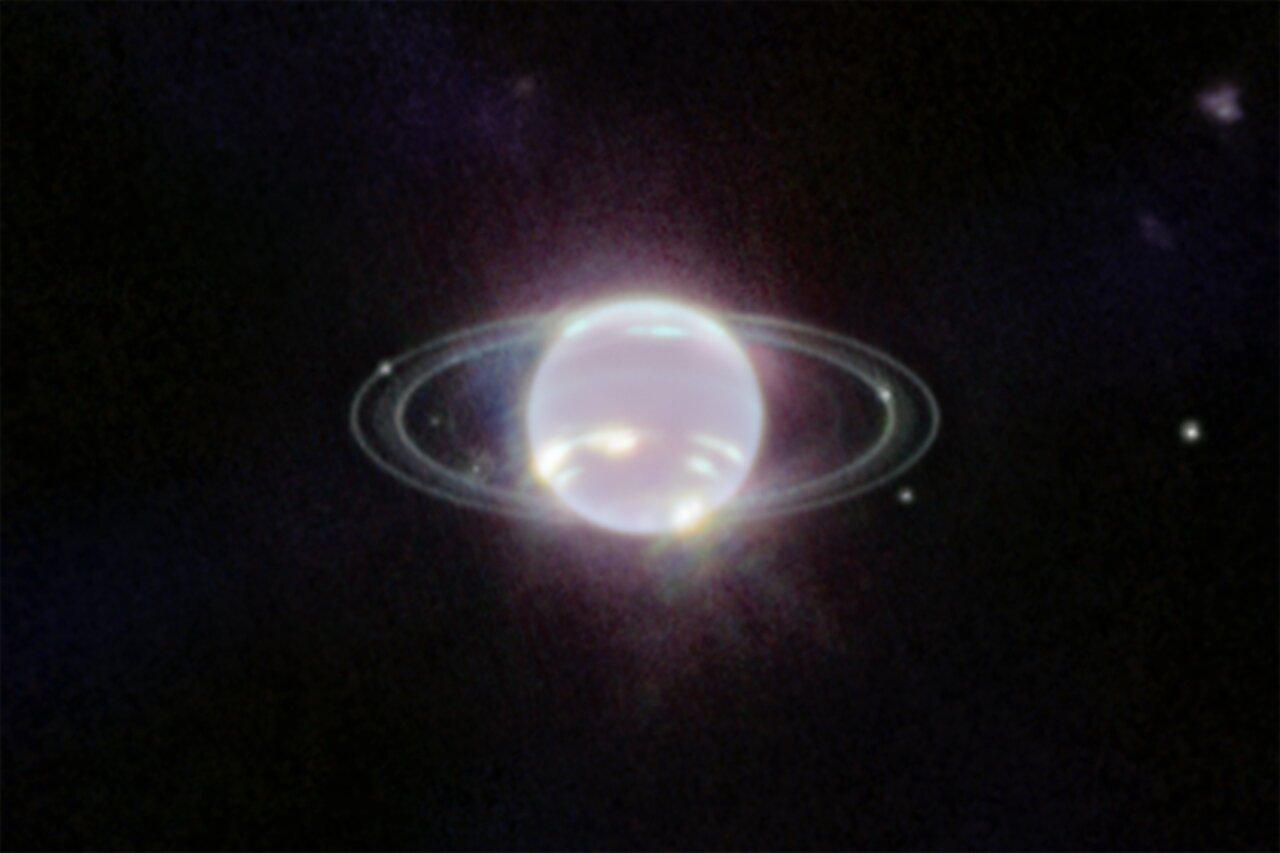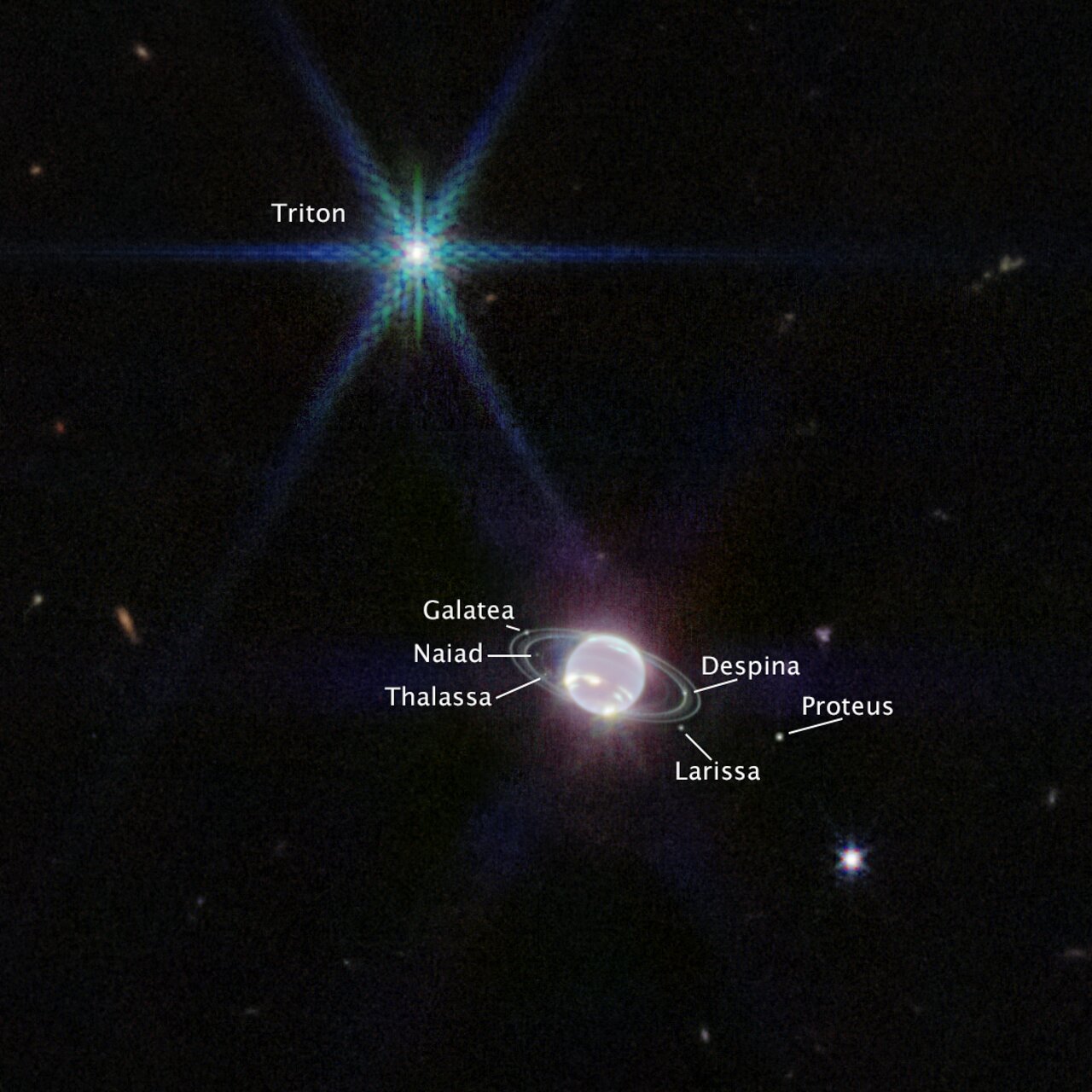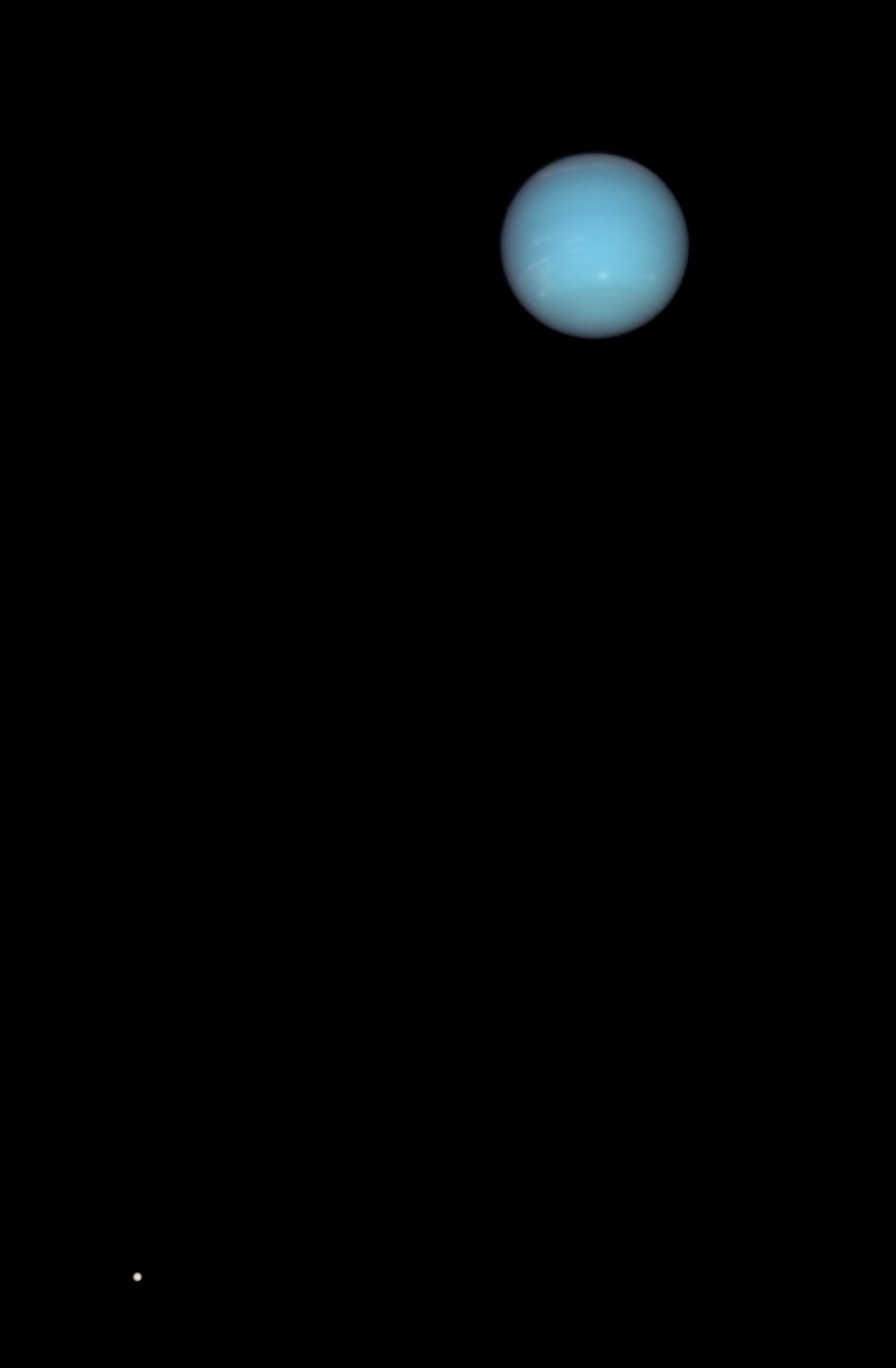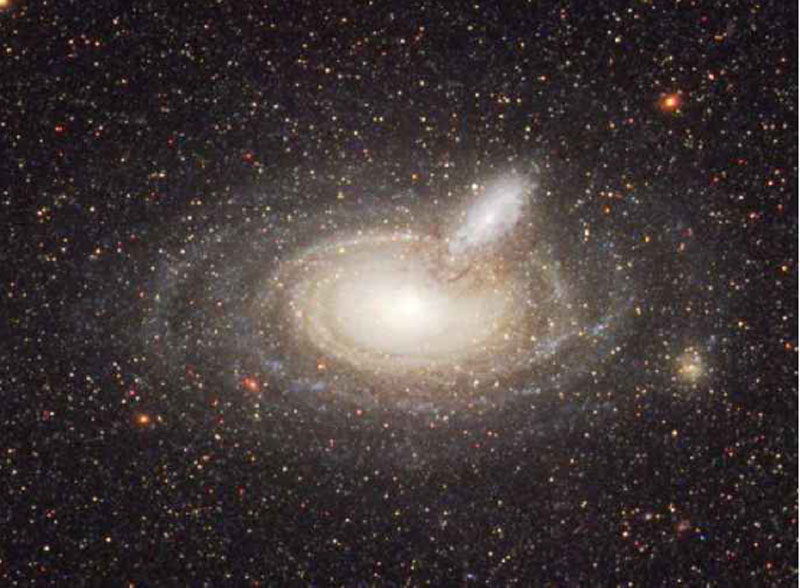The cosmos at our fingertips.
-
Ann
- 4725 Å
- Posts: 13843
- Joined: Sat May 29, 2010 5:33 am
Post
by Ann » Thu Sep 22, 2022 5:57 pm
bystander wrote: ↑Thu Sep 22, 2022 1:56 pm
New Webb Image Captures Clearest
View of Neptune’s Rings in Decades
ESA Webb |
ESA Space Science | 2022 Sep 21
Image Credit: NASA, ESA, CSA, and STScI
Most striking about Webb’s new image is the crisp view of the planet’s dynamic rings — some of which haven’t been seen at all, let alone with this clarity, since the Voyager 2 flyby in 1989. In addition to several bright narrow rings, the Webb images clearly show Neptune’s fainter dust bands. Webb’s extremely stable and precise image quality also permits these very faint rings to be detected so close to Neptune.
Neptune has fascinated and perplexed researchers since its discovery in 1846. Located 30 times farther from the Sun than Earth, Neptune orbits in one of the dimmest areas of our Solar System. At that extreme distance, the Sun is so small and faint that high noon on Neptune is similar to a dim twilight on Earth.
This planet is characterised as an ice giant due to the chemical make-up of its interior. Compared to the gas giants, Jupiter and Saturn, Neptune is much richer in elements heavier than hydrogen and helium. This is readily apparent in Neptune’s signature blue appearance in NASA/ESA Hubble Space Telescope images at visible wavelengths, caused by small amounts of gaseous methane. ...
ESA Webb wrote:
Triton, the bright spot of light in the upper left of this image, far outshines Neptune because the planet’s atmosphere is darkened by methane absorption wavelengths captured by Webb.
Of course!!!! Triton is brighter than Neptune in the infrared picture by Webb
for exactly the same reason why Neptune looks bluish in visible light: It is because methane in Neptune's atmosphere absorbs and dims infrared light detected by the Webb telescope, at the same time making Neptune bluish at optical wavelengths detected by Hubble - because the planet has "lost" some red and infrared light!!
Insert :slapface: emoji!!!
Ann
Last edited by
Ann on Thu Sep 22, 2022 6:49 pm, edited 1 time in total.
Color Commentator
-
Chris Peterson
- Abominable Snowman
- Posts: 18599
- Joined: Wed Jan 31, 2007 11:13 pm
- Location: Guffey, Colorado, USA
-
Contact:
Post
by Chris Peterson » Thu Sep 22, 2022 6:16 pm
Ann wrote: ↑Thu Sep 22, 2022 5:57 pm
Of course!!!! Triton is brighter than Neptune in the infrared picture by Webb
for exactly the same reason why it looks bluish in visible light: It is because methane in Neptune's atmosphere absorbs and dims infrared light detected by the Webb telescope, at the same time making Neptune bluish at optical wavelengths detected by Hubble - because the planet has "lost" some red and infrared light!!
Insert :slapface: emoji!!!
Reminds me of another face slapping thing that crops up when I'm teaching biology. I ask the kids what color light plants use for photosynthesis. "Duh... green of course. Chlorophyll is green!"
Bzzzz... wrong! They use red and blue light, and green least of all. They look green because they absorb the red and blue they need, leaving the useless green to reflect away.
-
Fred the Cat
- Theoretic Apothekitty
- Posts: 975
- Joined: Mon Feb 22, 2016 4:09 pm
- AKA: Ron
- Location: Eagle, Idaho
Post
by Fred the Cat » Fri Sep 23, 2022 3:29 pm
Chris Peterson wrote: ↑Thu Sep 22, 2022 6:16 pm
Ann wrote: ↑Thu Sep 22, 2022 5:57 pm
Of course!!!! Triton is brighter than Neptune in the infrared picture by Webb
for exactly the same reason why it looks bluish in visible light: It is because methane in Neptune's atmosphere absorbs and dims infrared light detected by the Webb telescope, at the same time making Neptune bluish at optical wavelengths detected by Hubble - because the planet has "lost" some red and infrared light!!
Insert :slapface: emoji!!!
Reminds me of another face slapping thing that crops up when I'm teaching biology. I ask the kids what color light plants use for photosynthesis. "Duh... green of course. Chlorophyll is green!"
Bzzzz... wrong! They use red and blue light, and green least of all. They look green because they absorb the red and blue they need, leaving the useless green to reflect away.
Depending on the
chlorophyl type and the type of
plant.
Of course, it's not always
black and
white.

Freddy's Felicity "Only ascertain as a cat box survivor"
-
bystander
- Apathetic Retiree
- Posts: 21592
- Joined: Mon Aug 28, 2006 2:06 pm
- Location: Oklahoma
Post
by bystander » Wed Oct 05, 2022 5:31 pm
Blog: Webb, Hubble Team Up to Trace
Interstellar Dust within a Galactic Pair
NASA | JWST | Blog | 2022 Oct 05
Image Credit: NASA, ESA, CSA, STScI, R. Windhorst (Arizona State Univ),
W. Keel (Univ of Alabama), S. Wyithe (Univ of Melbourne), & JWST PEARLS Team
“We got more than we bargained for by combining data from NASA’s James Webb Space Telescope and NASA’s Hubble Space Telescope! Webb’s new data allowed us to trace the light that was emitted by the bright white elliptical galaxy, at left, through the winding spiral galaxy at right – and identify the effects of interstellar dust in the spiral galaxy. This image of galaxy pair VV 191 includes near-infrared light from Webb, and ultraviolet and visible light from Hubble.
“Webb’s near-infrared data also show us the galaxy’s longer, extremely dusty spiral arms in far more detail, giving the arms an appearance of overlapping with the central bulge of the bright white elliptical galaxy on the left. Although the two foreground galaxies are relatively close astronomically speaking, they are not actively interacting. ...
“The image holds a second discovery that’s easier to overlook. Examine the white elliptical galaxy at left. A faint red arc appears in the inset at 10 o’clock. This is a very distant galaxy whose light is bent by the gravity of the elliptical foreground galaxy – and its appearance is duplicated. The stretched red arc is warped where it reappears – as a dot – at 4 o’clock. These images of the lensed galaxy are so faint and so red that they went unrecognized in Hubble data, but are unmistakable in Webb’s near-infrared image. Simulations of gravitationally lensed galaxies like this help us reconstruct how much mass is in individual stars, along with how much dark matter is in the core of this galaxy. ...
Webb's PEARLS: Dust Attenuation and Gravitational Lensing
in the Backlit-Galaxy System ~ William C. Keel
et al
Webb's PEARLS: Prime Extragalactic Areas for Reionization and Lensing
Science: Project Overview and First Results ~ Rogier A. Windhorst
et al
Know the quiet place within your heart and touch the rainbow of possibility; be
alive to the gentle breeze of communication, and please stop being such a jerk. — Garrison Keillor
-
Ann
- 4725 Å
- Posts: 13843
- Joined: Sat May 29, 2010 5:33 am
Post
by Ann » Wed Oct 05, 2022 7:14 pm
bystander wrote: ↑Wed Oct 05, 2022 5:31 pm
Blog: Webb, Hubble Team Up to Trace
Interstellar Dust within a Galactic Pair
NASA | JWST | Blog | 2022 Oct 05
Image Credit: NASA, ESA, CSA, STScI, R. Windhorst (Arizona State Univ),
W. Keel (Univ of Alabama), S. Wyithe (Univ of Melbourne), & JWST PEARLS Team
“We got more than we bargained for by combining data from NASA’s James Webb Space Telescope and NASA’s Hubble Space Telescope! Webb’s new data allowed us to trace the light that was emitted by the bright white elliptical galaxy, at left, through the winding spiral galaxy at right – and identify the effects of interstellar dust in the spiral galaxy. This image of galaxy pair VV 191 includes near-infrared light from Webb, and ultraviolet and visible light from Hubble.
“Webb’s near-infrared data also show us the galaxy’s longer, extremely dusty spiral arms in far more detail, giving the arms an appearance of overlapping with the central bulge of the bright white elliptical galaxy on the left. Although the two foreground galaxies are relatively close astronomically speaking, they are not actively interacting. ...
“The image holds a second discovery that’s easier to overlook. Examine the white elliptical galaxy at left. A faint red arc appears in the inset at 10 o’clock. This is a very distant galaxy whose light is bent by the gravity of the elliptical foreground galaxy – and its appearance is duplicated. The stretched red arc is warped where it reappears – as a dot – at 4 o’clock. These images of the lensed galaxy are so faint and so red that they went unrecognized in Hubble data, but are unmistakable in Webb’s near-infrared image. Simulations of gravitationally lensed galaxies like this help us reconstruct how much mass is in individual stars, along with how much dark matter is in the core of this galaxy. ...
Webb's PEARLS: Dust Attenuation and Gravitational Lensing
in the Backlit-Galaxy System ~ William C. Keel
et al
Webb's PEARLS: Prime Extragalactic Areas for Reionization and Lensing
Science: Project Overview and First Results ~ Rogier A. Windhorst
et al
Overlapping galaxies AM 1316-241. Image: NASA/ESA/Hubble Heritage.
Hubble has captured pictures of overlapping galaxies before. They sure are fascinating. Overlapping images reveal the long stretches of dusty spiral arms that are "barren" and don't give birth to stars.
Ann
Color Commentator





